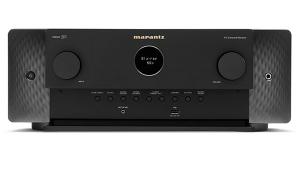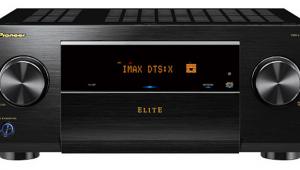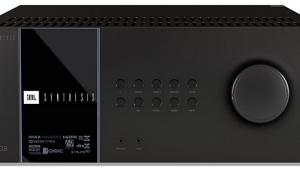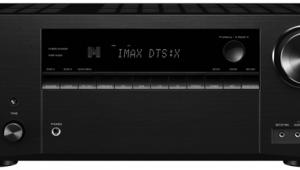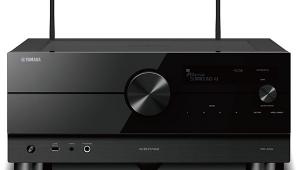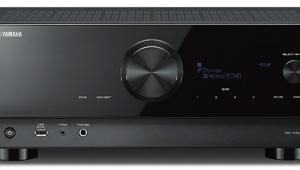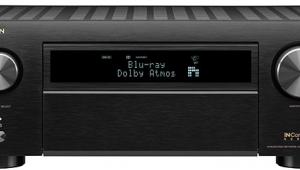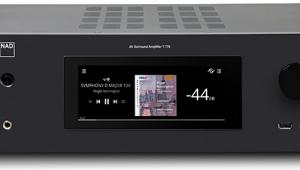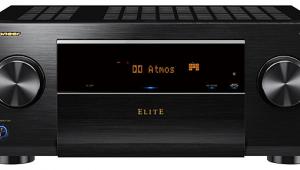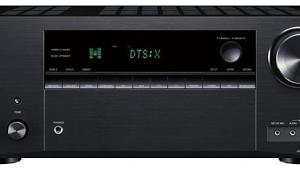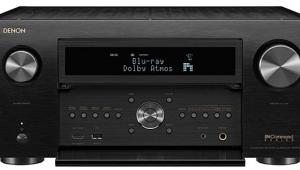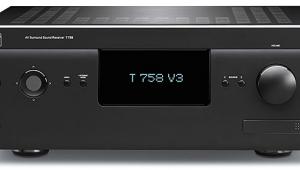Yamaha RX-V473 and RX-V573 A/V Receivers HT Labs Measures
Five channels driven continuously into 8-ohm loads:
N/A (protection engages)
Analog frequency response in Direct mode:
–0.23 dB at 10 Hz
–0.07 dB at 20 Hz
–0.03 dB at 20 kHz
–2.57 dB at 50 kHz
Analog frequency response with signal processing:
–0.64 dB at 10 Hz
–0.19 dB at 20 Hz
–0.40 dB at 20 kHz
–62.24 dB at 50 kHz

This graph shows that the RX-V473’s left channel, from Audio input to speaker output with two channels driving 8-ohm loads, reaches 0.1 percent distortion at 81.3 watts and 1 percent distortion at 96.5 watts. Into 4 ohms, the amplifier reaches 0.1 percent distortion at 126.5 watts and 1 percent distortion at 143.2 watts.
There was no multichannel input to measure. THD+N from the Audio input to the speaker output was less than 0.019 percent at 1 kilohertz when driving 2.83 volts into an 8-ohm load. Crosstalk at 1 kHz driving 2.83 volts into an 8-ohm load was –74.29 decibels left to right and –73.69 dB right to left. The signal-to-noise ratio with an 8-ohm load from 10 hertz to 24 kHz with “A” weighting was –110.35 dBrA.
From the Dolby Digital input to the loudspeaker output, the left channel measures –0.11 dB at 20 Hz and –8.87 dB at 20 kHz. The center channel measures –0.10 dB at 20 Hz and –11.82 dB at 20 kHz, and the left surround channel measures –0.12 dB at 20 Hz and –4.77 dB at 20 kHz. From the Dolby Digital input to the line-level output, the LFE channel is +0.14 dB at 20 Hz when referenced to the level at 40 Hz and reaches the upper 3-dB down point at 94 Hz and the upper 6-dB down point at 116 Hz. —MJP
Yamaha RX-V573 A/V Receiver
Five channels driven continuously into 8-ohm loads:
0.1% distortion at 20.8 watts
1% distortion at 24.9 watts
Seven channels driven continuously into 8-ohm loads:
N/A (protection engages)
Analog frequency response in Direct mode:
–0.23 dB at 10 Hz
–0.08 dB at 20 Hz
–0.04 dB at 20 kHz
–2.72 dB at 50 kHz
Analog frequency response with signal processing:
–0.66 dB at 10 Hz
–0.20 dB at 20 Hz
–0.35 dB at 20 kHz
–62.55 dB at 50 kHz
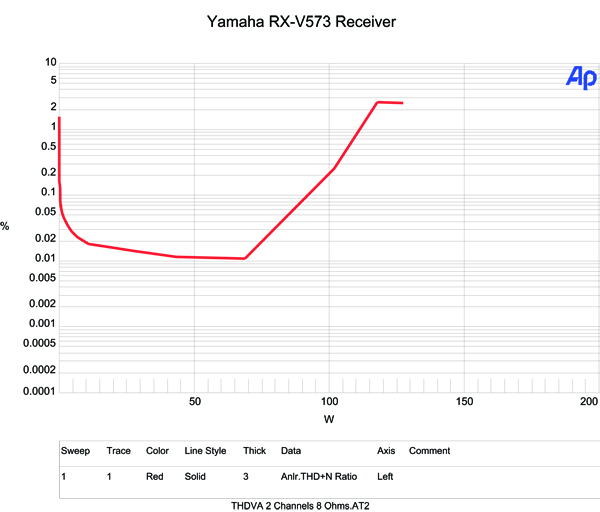
This graph shows that the RX-V573’s left channel, from Audio input to speaker output with two channels driving 8-ohm loads, reaches 0.1 percent distortion at 92.2 watts and 1 percent distortion at 111.4 watts. Into 4 ohms, the amplifier reaches 0.1 percent distortion at 102.0 watts and 1 percent distortion at 126.2 watts.
There was no multichannel input to measure. THD+N from the Audio input to the speaker output was less than 0.018 percent at 1 kilohertz when driving 2.83 volts into an 8-ohm load. Crosstalk at 1 kHz driving 2.83 volts into an 8-ohm load was –74.02 decibels left to right and –73.36 dB right to left. The signal-to-noise ratio with an 8-ohm load from 10 hertz to 24 kHz with “A” weighting was –110.56 dBrA.
From the Dolby Digital input to the loudspeaker output, the left channel measures –0.12 dB at 20 Hz and –0.33 dB at 20 kHz. The center channel measures –0.12 dB at 20 Hz and –0.28 dB at 20 kHz, and the left surround channel measures –0.11 dB at 20 Hz and –0.32 dB at 20 kHz. From the Dolby Digital input to the line-level output, the LFE channel is +0.14 dB at 20 Hz when referenced to the level at 40 Hz and reaches the upper 3-dB down point at 93 Hz and the upper 6-dB down point at 116 Hz.—MJP
Video Test Bench
MA HD and MA SD weren’t spectacular with either model, but I put them down as a pass because, although jaggies did start to appear in the yellow borderline zone of the jaggies test on the High-Definition Benchmark Blu-ray Disc, they weren’t pronounced. I didn’t notice any aliasing with real-world test video. Curiously, when I output 1080i video from my Oppo BD-93 to both receivers, they locked onto the 2:3:2:3 (PF-T) test quickly, putting a nigh-instant kibosh on moiré in the bleachers, but failed to do so at all when video output was set to 480i.—DB

